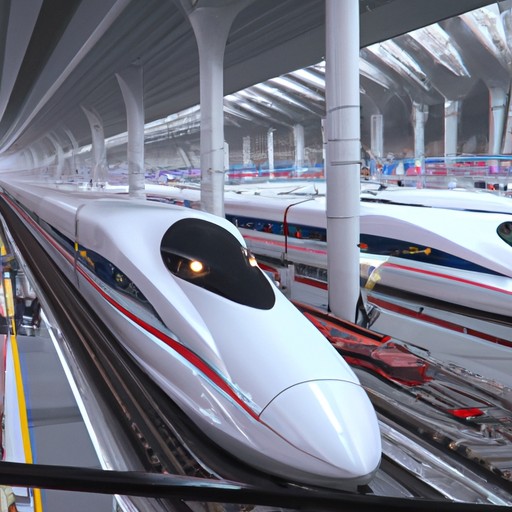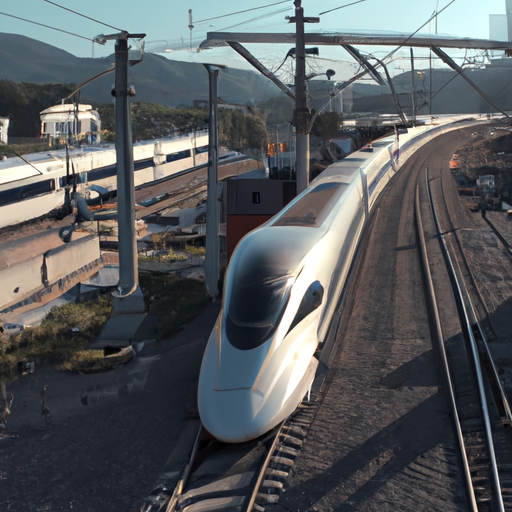The Rise of China’s High-Speed Rail: A New Engine for Economic Growth
The Economic Impact of China’s High-Speed Rail Development
China’s high-speed rail development has been nothing short of remarkable. Over the past few decades, the country has invested heavily in building a vast network of high-speed rail lines, connecting major cities and regions across the nation. This ambitious infrastructure project has not only transformed China’s transportation system but has also had a significant impact on its economy.
One of the key economic benefits of China’s high-speed rail development is the boost it has given to the construction industry. The construction of high-speed rail lines requires a massive amount of resources, including steel, cement, and other building materials. This has created a huge demand for these materials, leading to increased production and employment in the construction sector. As a result, the construction industry has become a major driver of economic growth in China.
Furthermore, the high-speed rail network has facilitated the movement of goods and people, leading to increased trade and tourism. With faster and more efficient transportation, businesses can now transport their products across the country more quickly and at a lower cost. This has helped to stimulate economic activity and promote regional integration. Additionally, the high-speed rail has made it easier for tourists to explore different parts of China, boosting the tourism industry and generating revenue for local businesses.
Another significant economic impact of China’s high-speed rail development is the creation of jobs. The construction and operation of high-speed rail lines have created a large number of employment opportunities, both directly and indirectly. Not only are there jobs in the construction sector, but there are also jobs in maintenance, operations, and customer service. This has helped to reduce unemployment rates and improve the standard of living for many Chinese citizens.
Moreover, the high-speed rail network has contributed to the development of secondary industries along its routes. As more people travel by high-speed rail, there is a growing demand for services such as hotels, restaurants, and retail outlets near train stations. This has led to the growth of these industries, creating additional employment opportunities and generating revenue for local businesses. The development of these secondary industries has also helped to diversify local economies and reduce their dependence on traditional industries.
In addition to these economic benefits, China’s high-speed rail development has also had positive environmental impacts. By providing a fast and convenient alternative to air and road travel, high-speed rail has helped to reduce carbon emissions and alleviate traffic congestion. This has not only improved air quality but has also contributed to the country’s efforts to combat climate change. Furthermore, the use of high-speed rail has reduced the demand for domestic flights, freeing up capacity at airports for international travel and boosting the aviation industry.
In conclusion, China’s high-speed rail development has had a profound economic impact on the country. It has stimulated economic growth, created jobs, promoted trade and tourism, and contributed to the development of secondary industries. Furthermore, it has had positive environmental effects by reducing carbon emissions and alleviating traffic congestion. As China continues to expand its high-speed rail network, the economic benefits are expected to grow even further, solidifying its position as a new engine for economic growth.
China’s High-Speed Rail Network: Infrastructure and Technology

China’s High-Speed Rail Network: Infrastructure and Technology
China’s high-speed rail network has emerged as a shining example of the country’s commitment to infrastructure development and technological advancement. With its extensive network and cutting-edge technology, China’s high-speed rail system has become a new engine for economic growth.
The development of China’s high-speed rail network began in the early 2000s, with the aim of connecting major cities and regions across the country. Today, China boasts the world’s largest high-speed rail network, covering over 22,000 miles of track. This vast network has not only improved connectivity within China but has also enhanced the country’s integration with the global economy.
One of the key factors behind the success of China’s high-speed rail network is its state-of-the-art infrastructure. The construction of high-speed rail lines requires significant investment in land acquisition, engineering, and technology. China has spared no expense in building a robust infrastructure to support its high-speed rail system. The tracks are designed to accommodate trains traveling at speeds of up to 217 miles per hour, ensuring a smooth and efficient journey for passengers.
In addition to the physical infrastructure, China has also invested heavily in the development of advanced technology for its high-speed rail system. The trains themselves are a marvel of engineering, equipped with cutting-edge features such as magnetic levitation, advanced signaling systems, and energy-efficient propulsion systems. These technological advancements not only enhance the speed and efficiency of the trains but also ensure passenger safety and comfort.
The high-speed rail network has had a transformative impact on China’s economy. It has facilitated the movement of goods and people, boosting trade and tourism across the country. The improved connectivity has also led to the development of new economic hubs along the high-speed rail lines, creating jobs and attracting investment. Moreover, the high-speed rail system has reduced travel time between major cities, making it easier for businesses to operate and for individuals to commute for work or leisure.
China’s high-speed rail network has also played a crucial role in promoting regional development and reducing regional disparities. By connecting remote and underdeveloped areas with major cities, the high-speed rail system has opened up new opportunities for economic growth and improved the quality of life for millions of people. It has helped bridge the urban-rural divide and fostered a more inclusive and balanced development across the country.
Furthermore, China’s high-speed rail system has become a symbol of the country’s technological prowess and innovation. It has showcased China’s ability to develop and implement complex infrastructure projects on a massive scale. The success of the high-speed rail network has not only boosted China’s international reputation but has also inspired other countries to invest in their own high-speed rail systems.
In conclusion, China’s high-speed rail network is a testament to the country’s commitment to infrastructure development and technological advancement. With its extensive network and cutting-edge technology, the high-speed rail system has become a new engine for economic growth in China. The state-of-the-art infrastructure and advanced technology have not only improved connectivity within the country but have also enhanced China’s integration with the global economy. The high-speed rail network has transformed the way people travel, boosted trade and tourism, promoted regional development, and showcased China’s technological prowess. As China continues to expand its high-speed rail network, the country is poised to reap even greater economic benefits and solidify its position as a global leader in high-speed rail technology.
The Role of China’s High-Speed Rail in Regional Connectivity and Integration
China’s high-speed rail network has emerged as a powerful force in driving economic growth and regional connectivity. With its extensive reach and impressive speed, the high-speed rail system has become a vital tool for integrating China’s vast regions and promoting economic development.
One of the key roles of China’s high-speed rail is to connect different regions within the country. China is a vast country with diverse landscapes and a large population. Historically, transportation between regions has been a challenge, hindering economic integration and development. However, the high-speed rail network has changed this dynamic by providing fast and efficient transportation options.
The high-speed rail system has significantly reduced travel times between major cities, making it easier for people to commute for work or leisure. For example, the journey from Beijing to Shanghai, which used to take over 10 hours by conventional train, can now be completed in just four and a half hours. This improved connectivity has not only facilitated business activities but also boosted tourism and cultural exchanges between different regions.
Moreover, the high-speed rail network has played a crucial role in promoting regional integration. By connecting previously isolated regions, the rail system has facilitated the flow of goods, services, and people, creating new opportunities for economic growth. For instance, the high-speed rail has enabled the development of new industrial clusters in less developed regions, as businesses can now easily access larger markets and resources.
In addition to connecting regions within China, the high-speed rail network has also enhanced connectivity with neighboring countries. China’s Belt and Road Initiative, which aims to promote trade and infrastructure development along ancient trade routes, has been greatly supported by the high-speed rail system. The rail links have improved transportation efficiency and reduced costs, making it easier for goods to be transported across borders.
Furthermore, the high-speed rail system has contributed to the development of China’s less developed regions. By connecting these regions to major economic hubs, the rail network has attracted investments and stimulated economic activities. This has helped to reduce regional disparities and promote balanced economic growth across the country.
The high-speed rail system has also had a positive impact on the environment. By providing a fast and convenient alternative to air travel, the rail network has reduced the demand for domestic flights, resulting in lower carbon emissions. Additionally, the high-speed trains themselves are more energy-efficient compared to conventional trains, further reducing the environmental footprint of transportation.
In conclusion, China’s high-speed rail network has become a powerful engine for economic growth and regional connectivity. By connecting different regions within China and promoting integration with neighboring countries, the rail system has facilitated the flow of goods, services, and people, creating new opportunities for economic development. Moreover, the high-speed rail has contributed to the development of less developed regions, reduced regional disparities, and promoted balanced economic growth. With its impressive speed and extensive reach, the high-speed rail system has truly transformed China’s transportation landscape and played a crucial role in driving economic growth.



